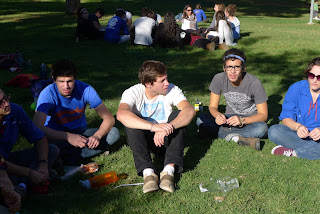This week, the chanichim traveled around the country, meeting former members of Habonim Dror who have gone on to live in Israel and founded kibbutzim. The central question of the week was: what is the hagshama (actualization) of Habonim Dror? Through exploring the evolution of the kibbutz movement, from it's early years during the Second Aliyah (1904-1914) until it's decline in the 1990s and reemergence in the 2000s, the chanichim were presented with a history of Habonim's activities in Israel. Habonim founded approximately 50 kibbutzim in Israel since its creation in 1929, and today its graduates are taking an active role in creating new forms of kibbutzim. The seminar included trips to the Kinneret Cemetery, Kinneret Courtyard, Kibbutz Amiad, Kibbutz Tuval, Kibbutz Yizrael, Kibbutz Eshbal, Kibbutz Mishoal (located in Nazereth), a panel about HDNA in the 1990s, an urban kibbutz in Acco, and concluded with a visit to the home of the most recent olim from HDNA in Haifa.

In the Kinneret Cemetery.
At the grave of Beryl Katznelson, writer of the Second Aliyah
and founder of the Histadrut (union).
At the grave of the poet Rachel.
Playing around at Kinneret Courtyard, a heritage site
of the first training farm of the pioneers in Palestine.
Kinneret Courtyard.
Kinneret Courtyard.
Kinneret Courtyard.
At Kibbutz Tuval overlooking the Galilee, with Neil Harris.
Kibbutz Tuval.
Carmiel is visible in the distance.
Meeting Gary Bennet, former Galilnik and current member
of Kibbutz Beit HaEmek.
Next week, Workshop 62 will be concluding their time on Kibbutz Ein Dor. On Sunday the 16th, they will be moving to their new homes in Carmiel and Rishon Letzion. We look forward to seeing those of you that are visiting Israel this winter, and a Happy Hannukah to everyone!



















































